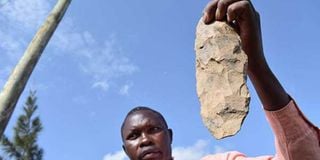New cradle of mankind found in Nyeri, complete with stone tools

Francis Kinyua on June 20, 2018displays a hand axe which was among stone tools he found in Gatarakwa, Nyeri County. The tools are believed to have been made by the early man. PHOTO | JOSEPH KANYI | NATION MEDIA GROUP
What you need to know:
- The Nyeri tools were discovered by 51-year-old archaeologist and farmer Richard Kinyua.
- He said it is possible there is an archaeological site in Gatarakwa.
- Last year, an early human species classified as Australopithecus Afarensis dating close to 3.5 million years was discovered near Ngong Hills.
A Kenyan archaeologist has discovered ancient stone artefacts in Nyeri County, opening a new frontier in the study of human origins and evolution of technology.
The stone tools are similar to those found in the world-famous Olorgesailie site on the road to Lake Magadi, and which date close to 1.2 million years. Similar stone tools have been found in Kariandusi in the Rift Valley.
The artefacts, which include Acheulian hand axes, were found in Gatarakwa, Kieni, on the foothills of the Aberdare Ranges.
Their discovery changes the narrative on the early human habitat as it means earLy man could have lived in the highlands and not just on the floor of the Rift Val-ley, as previously thought.
AUSTRALOPITHECUS AFARENSIS
Last year, an early human species classified as Australopithecus Afarensis and dating close to 3.5 million years was discovered near Ngong Hills on the outskirts of Nairobi, the first such site in the highlands.
Previously, early man was thought to have occupied the open grasslands only, but new evidence is now leading scientists to the woodlands, too.
The Nyeri tools were discovered by 51-year-old archaeologist and farmer Richard Kinyua.
They have a striking similarity to those used by Homo Erectus.
Mr Kinyua discovered the stones in April this year on the Kiawara-Belleview Road, which is under construction.
COLLECTING ARTEFACTS
A past student of archaeology at the University of Nairobi, he says he has been collecting artefacts and conducting research on the site for the past two decades.
Professor Christopher Nyamai, a geologist at the University of Nairobi, described the findings as unique. He said they are being studied.
Although he declined to give further details, he said it is possible there is an archaeological site in Gatarakwa.
“It is a bit unique and may be a first of its kind. Anything is possible but it depends on the facts on the ground. There have been a few artefacts that have been identified and we have been working with archaeologists on the matter,” Professor Nyamai said when contacted by the Nation.
Mr Kinyua’s findings came almost by chance as they were excavated unknowingly by construction workers.
“As they were grading and digging the road, I would follow them searching for clues. After the recent heavy rains, I spotted a rock that looked a bit different. I gave it a closer look and realised it was actually an early man tool,” he says.
HAND AXE
On further examination, Mr Kinyua was convinced that the rock had an identical formation to that of a hand axe made by Homo Erectus.
“Looking at the edges and the flaking on the stone, it is evident this was a hand axe used by early man,” he explains.
The discovery pushed him to set up a roadside museum and to map out a study area where he dug for more clues. His efforts bore fruit and he has so far collected more than 40 artefacts.
From the samples collected, he has identified tools that were possibly used by ear-ly man, among them a hand axe, light hand axe, stone hammer, flakes and discoid.
Hand axes are believed to have been multipurpose tools for cutting and crushing.
Flakes and discoid were used for slaughtering while stone hammers were for carving out tools and crushing.
Mr Kinyua and various other scientists now believe early man could have lived in the highlands and not just in the Rift Valley.
EARLY MAN
“Maybe this is where early man originated and later moved to the Rift Valley. This area is very rich for research,” he says.
Initially, most scientific research on the origin of mankind focused on the Rift Val-ley where several archaeological sites have been set up.
The most famous sites in the Rift Valley are: Kariandusi Prehistoric Site in Elmentaita, Olorgesalie near Lake Magadi, Hyrax Hill in Nakuru and Koobi Fora in Turkana.
Theories of possible habitation of the highlands by early man emerged around 1997 after palaeontologists researched on fossils found in Gatarakwa.
But there was no tangible proof to substantiate the theory.
“We studied a site known as Nguruwe but there wasn’t sufficient evidence at the time. But right now these findings are enough evidence to carry forward the re-search,” Mr Kinyua says.
Mr Kinyua is an enthusiast scholar of archaeology and evolution. But he faces many constraints, among them finances and preservation of the site.
With the ongoing road construction and human activities in the area, he is afraid that some crucial artefacts may be lost.




